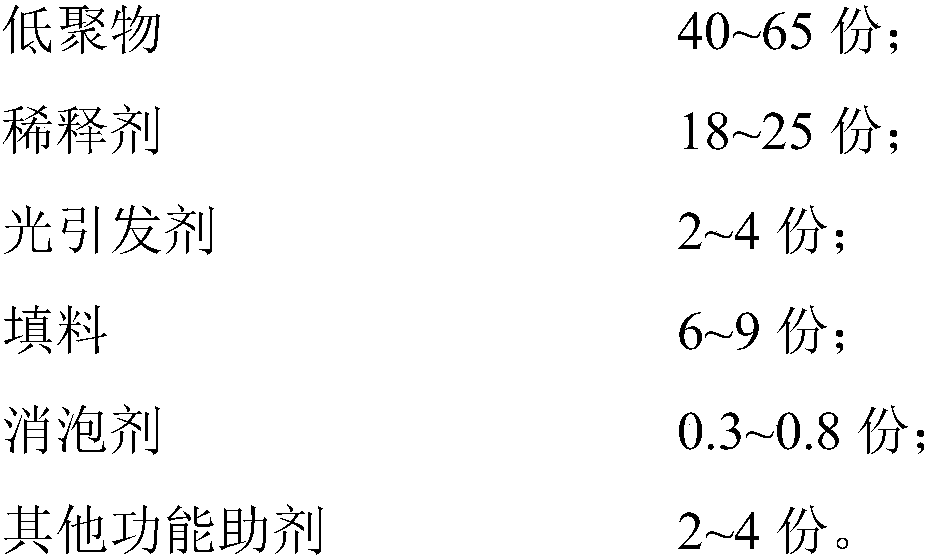Ultraviolet light curing high-hardness material used for 3D printing and preparation method of high-hardness material
A 3D printing and ultraviolet light technology, applied in the field of 3D printing materials, can solve the problems of ultraviolet curing high hardness materials that have not been reported, and achieve the effects of high light transmittance, wide application and high tensile strength
- Summary
- Abstract
- Description
- Claims
- Application Information
AI Technical Summary
Problems solved by technology
Method used
Image
Examples
Embodiment 1
[0072] A 3D printing UV-curable high-hardness material, in parts by weight, at least includes the following components:
[0073]
[0074] Wherein, the functionality of the high-functionality epoxy acrylate (DR-G908) is 6, the functionality of the hyperbranched polyester acrylate (DR-E522) is 15-18, and the thinner diethylene diacrylate The addition ratio of alcohol dimethacrylate (EM329) to trimethylolpropane triacrylate (EM231) is 0.6:1.
[0075] Mix and heat DR-G908, DR-E522, EM329, EM231, nano-silica, BYK-110, 55% BYK-065, EFKA-3030, silanol non-ionic surfactant, sodium hypophosphite, and stir The speed is 2800rad / min, after uniform dispersion, add 1-hydroxycyclohexyl benzophenone, continue to stir, the stirring speed is 2500rad / min, add the remaining BYK-065 after the system is uniformly dispersed, continue stirring, the stirring speed is 1150rad / min min until the system is uniform and free of air bubbles, and then stored at low temperature and protected from light.
Embodiment 2
[0077] A 3D printing UV-curable high-hardness material, in parts by weight, at least includes the following components:
[0078]
[0079] Wherein, the functionality of the high-functionality epoxy acrylate (DR-G908) is 6, the functionality of the hyperbranched polyester acrylate (DR-E522) is 15-18, and the thinner diethylene diacrylate The addition ratio of alcohol dimethacrylate (EM329) to trimethylolpropane triacrylate (EM231) is 0.6:1.
[0080] Mix and heat DR-G908, DR-E522, EM329, EM231, nano-silica, BYK-110, 55% BYK-065, EFKA-3030, silanol non-ionic surfactant, sodium hypophosphite, and stir The speed is 2800rad / min, after uniform dispersion, add 1-hydroxycyclohexyl benzophenone, continue to stir, the stirring speed is 2500rad / min, add the remaining BYK-065 after the system is uniformly dispersed, continue stirring, the stirring speed is 1150rad / min min until the system is uniform and free of air bubbles, and then stored at low temperature and protected from light.
Embodiment 3
[0082] A 3D printing UV-curable high-hardness material, in parts by weight, at least includes the following components:
[0083]
[0084]
[0085] Wherein, the functionality of the high-functionality epoxy acrylate (DR-G908) is 6, the functionality of the hyperbranched polyester acrylate (DR-E522) is 15-18, and the thinner diethylene diacrylate The addition ratio of alcohol dimethacrylate (EM329) to trimethylolpropane triacrylate (EM231) is 0.6:1.
[0086]Mix and heat DR-G908, DR-E522, EM329, EM231, nano-silica, BYK-110, 55% BYK-065, EFKA-3030, silanol non-ionic surfactant, sodium hypophosphite, and stir The speed is 2800rad / min, after uniform dispersion, add 1-hydroxycyclohexyl benzophenone, continue to stir, the stirring speed is 2500rad / min, add the remaining BYK-065 after the system is uniformly dispersed, continue stirring, the stirring speed is 1150rad / min min until the system is uniform and free of air bubbles, and then stored at low temperature and protected fro...
PUM
| Property | Measurement | Unit |
|---|---|---|
| particle diameter | aaaaa | aaaaa |
| Functional group degree | aaaaa | aaaaa |
Abstract
Description
Claims
Application Information
 Login to view more
Login to view more - R&D Engineer
- R&D Manager
- IP Professional
- Industry Leading Data Capabilities
- Powerful AI technology
- Patent DNA Extraction
Browse by: Latest US Patents, China's latest patents, Technical Efficacy Thesaurus, Application Domain, Technology Topic.
© 2024 PatSnap. All rights reserved.Legal|Privacy policy|Modern Slavery Act Transparency Statement|Sitemap



